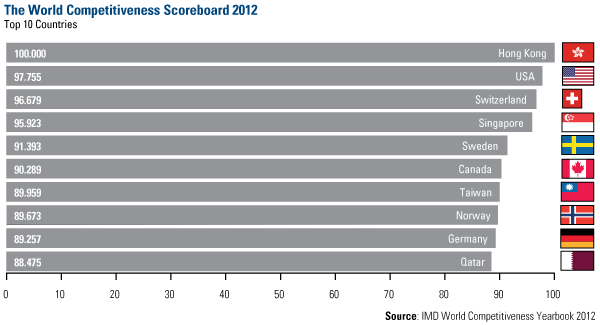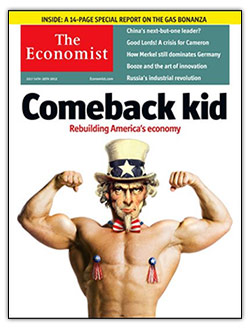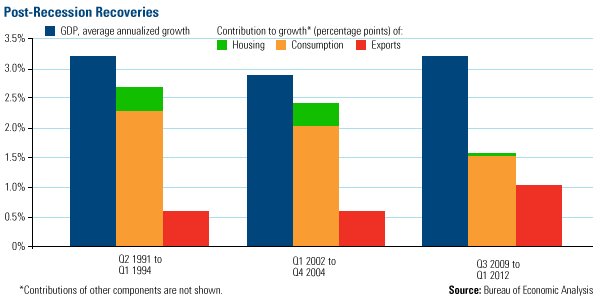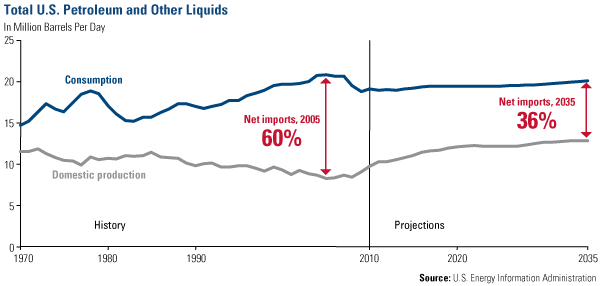…[In spite of the fact that] our economy is still struggling to regain its strength [as a result of] stubborn unemployment and sluggish growth at home combined with a slowing China and a dysfunctional eurozone have cast a dark shadow on America’s eternal optimism….I believe there is nowhere else in the world where opportunity abounds and initiative is rewarded as it is in the U.S.A.. [This is confirmed by] the findings of IMD’s annual World Competitiveness Yearbook which surveyed more than 4,200 international executives as to how well countries manage their economic and human resources to increase prosperity. Of the 59 ranked economies in 2012, the U.S. ranked 2nd. Words: 734
[as a result of] stubborn unemployment and sluggish growth at home combined with a slowing China and a dysfunctional eurozone have cast a dark shadow on America’s eternal optimism….I believe there is nowhere else in the world where opportunity abounds and initiative is rewarded as it is in the U.S.A.. [This is confirmed by] the findings of IMD’s annual World Competitiveness Yearbook which surveyed more than 4,200 international executives as to how well countries manage their economic and human resources to increase prosperity. Of the 59 ranked economies in 2012, the U.S. ranked 2nd. Words: 734
So says Frank Holmes (www.usfunds.com) in edited excerpts from his original article*.
Lorimer Wilson, editor of www.munKNEE.com (Your Key to Making Money!) and www.FinancialArticleSummariesToday.com (A site for sore eyes and inquisitive minds) has edited the article below for length and clarity – see Editor’s Note at the bottom of the page. This paragraph must be included in any article re-posting to avoid copyright infringement.
Holmes goes on to say, in part:
IMD, a well-regarded Swiss business school, had this to say in their comments regarding the U.S. “Despite all its setbacks, the U.S. remains at the center of world competiveness because of its unique economic power, the dynamism of its enterprises and its capacity for innovation”.

Barron’s editorial page editor Thomas G. Donlan wrote, “It’s worth contemplating the advantages that a group of international business executives and analysts still can find in the U.S. economy. At the top is access to financing, following a strong research-and-development culture, an effective legal environment, dynamism of the economy, a skilled workforce, and reliable infrastructure. At the bottom, they find the U.S. lacks competency of government and a competitive tax regime.”
During tough times, Americans must be vigilant in safeguarding our competitive edge by continuing to be a compassionate and generous nation while resisting the siren calls of socialism. A system that strangles private property rights and sponsors excessive bureaucracy, regulation and taxation cannot deliver on a promise of prosperity to its people. We must not lose our collective faith in capitalism because it has proven to be the only social system that rewards individual ability, initiative and achievement.
What Henry Ford said a century ago holds true today, “What’s right about America is that although we have a mess of problems, we have great capacity—intellect and resources—to do something about them.”

The Economist’s cover story last week heralded America’s economy the “Comeback kid.” “Led by its inventive private sector, the economy is remaking itself. Old weaknesses are being remedied and new strengths discovered, with an agility that has much to teach stagnant Europe and dirigiste Asia,” according to the story.
The story notes that while America’s overall growth is unimpressive, some components show signs of boom. We have shifted from a consumption-driven economy to a more outward-facing one. In the post-recession economy exports contributed 43 percent of growth, one of the strongest showings in any recent economic recovery. While sales to traditional markets in the OECD have risen just 20 percent since the end of 2007, they are up 51 percent to Latin America and 53 percent to China.

According to The Economist, emerging markets have also reinvigorated America’s role as a big commodity producer. Grain exports are soaring, agricultural land values are rising, and higher oil prices have triggered new output. American innovation in discovering new techniques to release oil and gas from shale has paid massive dividends to the energy sector and created thousands of new jobs in the industry….
Cheap, plentiful natural gas benefits industries as diverse as glass, fertilizers, plastic and steelmakers. Last year for the first time in decades, America became a net exporter of refined products – and our nation’s gap between oil consumption and domestic production is shrinking.

A way to take advantage of a potential upturn in commodities is by choosing dividend-paying global resources equities. In the S&P 500 Index, nearly all of the materials and utilities stocks and more than half of energy companies pay a dividend that is higher than the 10-year Treasury. Materials and utilities companies yield an average of 2.3 percent and 4.1 percent, respectively, while energy stocks pay an average yield of 2.2 percent….
Take Note:
We believe there are many great American companies to invest in. We like those that are growing their top line revenues and paying robust dividends. Currently 47 percent of the S&P 500 stocks pay a dividend yielding more than a 10-year Treasury, demonstrating the resiliency and strength of American enterprises.
Professor Stephane Garelli, director of IMD’s World Competitiveness Center, said, “U.S. competiveness has a deep impact on the rest of the world because it is uniquely interacting with every economy, advanced or emerging. No other nation can exercise such a strong ‘pull effect’ on the word. In the end, if the U.S. competes, the world succeeds!”
*http://www.usfunds.com/media/files/pdfs/investor-alert/-2012-ia/2012-07-20/investor_alert-07202012.pdf (To access the above article please copy the URL and paste it into your browser.)
Editor’s Note: The above article may have been edited ([ ]), abridged (…), and reformatted (including the title, some sub-titles and bold/italics emphases) for the sake of clarity and brevity to ensure a fast and easy read. The article’s views and conclusions are unaltered and no personal comments have been included to maintain the integrity of the original article.
Related Articles:
1. What Recession? This Chart Shows Otherwise
Deutsche Bank’s Joe LaVorgna tracks payroll tax receipts as a measure of real-time labor market health [see an earlier article on that chart and a host of others here] and the latest data for the current quarter show receipts growing 6% year-over-year. [It brings into question all those purveyors of doom who claim that a recesssion is just around the corner.]
2. A Balanced Analysis Suggests a Recession is NOT Imminent – Here’s Why
The permabears are coming out the woodwork. Bad, scary articles and news seem to attract more attention and eyeballs than good news articles or those that offer a counterbalanced view. Whenever someone gets interviewed on US TV, it’s for someone proclaiming the end of the expansion – you never see them interviewing someone offering a counter view of a more positive nature. This article gives you a balanced, opposing view to the tiresome popular perma-bear consensus so that you can make your own balanced decision. [As for our own conclusion, we don’t see imminent recession. Here’s why.] Words: 1315
3. “Joe’s Index” Suggests Joe Sixpack Coming Back to the Consumption Trough
Econintersect has been playing with an economic index based on the world as seen by Joe Sixpack. For lack of a final name, we have used a development tag of “Joe’s Index” which is based on Joe’s real income and the change in his home value, which, to various degrees, Joe sees as income (and/or wealth) gain or loss. Joe’s Index is indicating Joe Sixpack is coming back to the consumption trough. [Let us explain why we have come to that conclusion.] Words: 380
4. America’s Economic Advantage is Immigrants! Here’s Why
The American age demographic profile is substantially better than its major trading partners, driven by the combination of a rising working age population as the children of the post-war Baby Boomers grow up and enter the work force and substantial immigration [legal or otherwise. This profile has major economic dividends as outlined in this article.] Words: 530
 munKNEE.com Your Key to Making Money
munKNEE.com Your Key to Making Money
